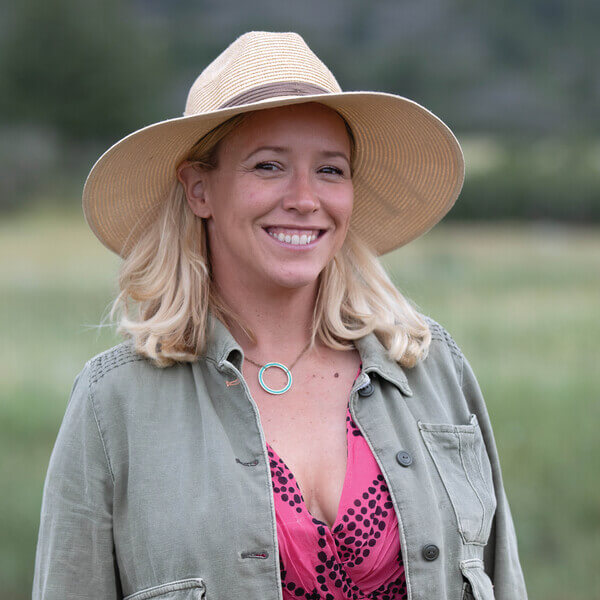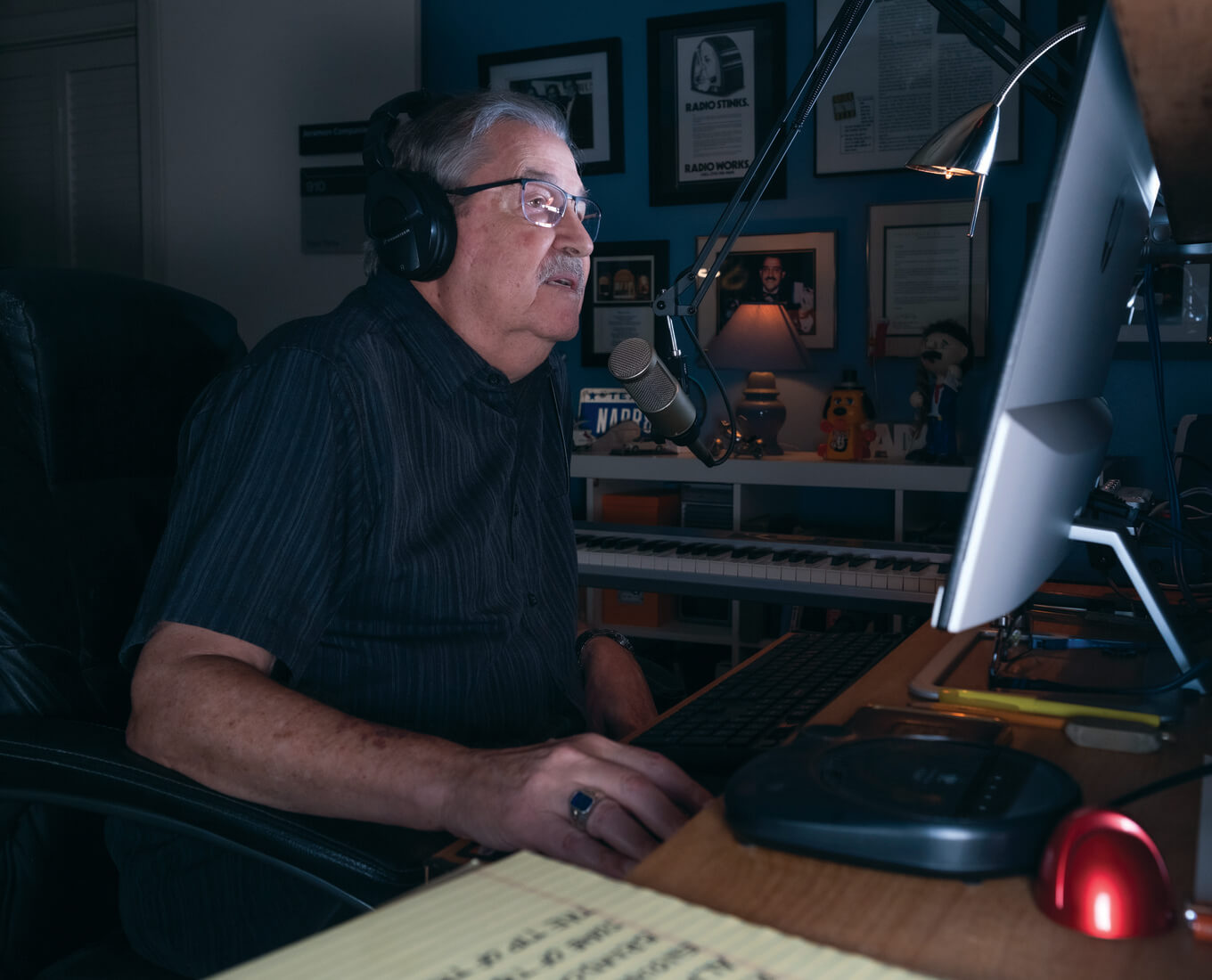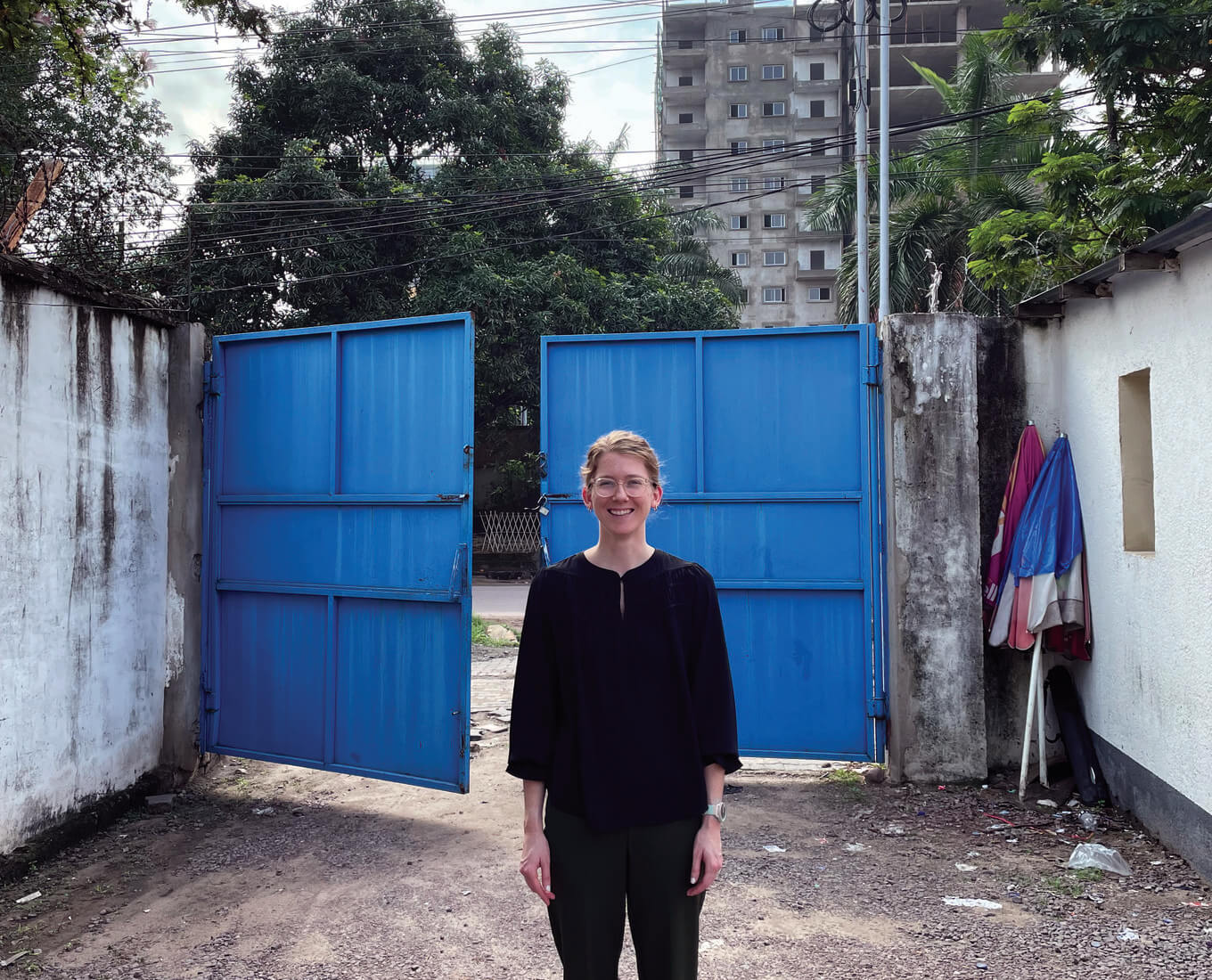Megan Knott ’03 runs a remote fifth-generation ranch, Knott Land and Livestock, in Colorado’s Upper Trout Creek Valley with her husband, Tyler, and their two children. The skies are dark and star-filled, and she can hear the sound of elk bugling from her deck.
Recently named among America’s Best Young Farmers and Ranchers, Knott and her husband are committed to not only providing locally sourced food but also protecting the land and rivers as a wildlife habitat via their business, Trout Creek Meats. Through her other role as senior director of stewardship at Colorado Cattlemen’s Agricultural Land Trust (CCALT), Knott is ensuring families across Colorado can preserve precious agricultural lands and wild spaces.
But how did a New Jersey girl end up in the Colorado wilderness — by way of The Hill? Knott took a rare break from 24/7 ranch life to tell us.
FIRST, A FEW QUESTIONS ABOUT YOU, Megan
Where did you grow up?
I grew up in Warren, New Jersey. It was pretty suburban, but we still had creeks and woods to play in. I spent my summers in Maine, which is where I really developed my love of the outdoors.
When you were young, what did you want to be when you grew up?
I wanted to be a veterinarian for the longest time because I was pretty obsessed with animals. When I was little, I begged my parents for horses and cows. Though my career path was a bit different, I do plenty of vet work at the ranch, delivering babies, vaccinating, treating wounds and broken bones. The closest vet office is an hour from the ranch. We do have them come out for emergencies, like C-sections. And when they do, we try to pick up as much knowledge as possible.
What’s something you miss from the East Coast?
I miss the East Coast all the time. It’s something my family can’t comprehend. I miss the water. You have so much water back there. I miss the ocean and its constant influence on the weather. I miss the enveloping forest and the mystery of never knowing what is around the bend. My husband says it makes him claustrophobic. Out West, you can see for miles. When I first moved out here, I remember consciously observing how the landscapes in my dreams changed. Western landscapes are so wide open, exposed and celestial. It’s almost like you can’t hide from your fate.
How do you relax?
I like to gravel bike. Every summer, I compete in a few races around the state. My longest ride yet was a 76K with 4,700 feet in elevation gain; real Type 2 fun.
What is the first thing you do when you wake up?
Cook. I am always cooking! My son thinks it’s my favorite activity. It’s not.
What’s the last TV show you recommended to a friend?
Ha ha, I have no time for TV. I actually sit on our couch maybe once every few weeks when the kids want to watch a movie. I find it very hard to sit still.
Go-to coffee order?
We brew our own. The closest coffee shop is half an hour away. That being said, I do like lattes.
What three places are on the top of your travel bucket list?
I am really not much of a traveler. Over time, I’ve come to appreciate really getting to know a single place. The knowledge that one place can instill in you as you watch it change over time, with changing seasons, a changing climate, and changing external influences (e.g., economic pressures), teaches lessons about fragility and resiliency. While I have travelled some and always appreciate the lessons of drastic difference, lessons of subtle difference can be important too. There's always a balance between breadth and depth. Lately, I’ve been leaning in on depth. All that being said, I’d like to bike Iceland.
What is your phone background? Why did you pick this image?
I have my phone set to rotate images because they are all so amazing and the surprise of a cute memory makes me happy. I have a hidden skill as a photographer. I’ve had the 2nd-place image in the Colorado Department of Agriculture’s Best In Show Photography contest twice! I love taking pictures of my kids experiencing this life.
What’s the last book you recommended to a friend?
I have a few books open, sitting next to my bed. On the rare occasion I take a vacation, I can usually finish one. Since I am usually on the go, I have really developed a podcast affinity. I’ll listen to a podcast about anything. I love The Daily and This American Life. Have you listened to the New York Times special, Animal? I frequently listen to outdoor survival stories. I recommend podcasts all the time.
ON KNOTT LAND AND LIVESTOCK & TROUT CREEK MEATS
How did life take you from New Jersey to a ranch in Colorado?
You can imagine it’s a common question how a girl from New Jersey ended up on a remote ranch just 5 miles outside the Flat Tops Wilderness area. My passion has always been for the environment. I attended Holy Cross as a scholarship athlete, playing Division I softball to pay for my science-focused education.
After college, I opted for the technical skills of a field-based graduate school experience, earning two master’s degrees from Duke University. Amongst the slash piles of coastal loblolly pine operations, I developed a deep appreciation for the foresters and farmers who worked the land, and the interconnectedness of food and fiber production and health of the landscapes that produce them.
I pursued this new passion wholeheartedly, seeking employment at nonprofits whose missions focused not around preservation of wild places void of human interference, but on embracing people as part of the natural world, living holistically with the land and caring for it as a member of the family. The stories of place inextricably tied to human experience inspired me, leading me to realize my true passion was not for the environment as much as for our place within it. I married a rancher, and my children are growing up riding horses, bottle feeding lambs and caring for the land.
Where is your ranch located, and what land does it encompass?
The Knott family’s ancestors moved to the Upper Trout Creek Valley some 85 years ago and the family has been actively ranching the area since that time. My husband is the fourth generation of the Knott family to manage the operation. The entire ranch is an approximately 17,000-acre cow/calf and sheep operation comprised of 2,400 acres of deeded land. We sit 4 miles west of Oak Creek, Colorado, on the border of the White River National Forest, just 5 miles from the Flat Tops Wilderness Area boundary.
I can hear elk bugle from my deck. Our skies are very dark. It’s a place that is still wild. Though, I guess I mean as wild as it can be today. We have internet, planes fly over all the time, the night sky is filled with satellites. It shocked me how fast COVID-19 spread to our community. We are not as wild and remote as we once were.
What is the mission and focus of Knott Land and Livestock and Trout Creek Meats?
Knott Land and Livestock is the family ranching business. Trout Creek Meats is a subset my husband and I run. While the ranch is still a commercially operated cow/calf operation, the meat business is a value-added branch. And I don’t mean only economic value. The real value of the meat business is connecting the consumer to food production. COVID-19 exposed holes in Colorado’s food and agricultural supply chain. When grocery stores’ shelves went bare, the demand for locally produced products in our region skyrocketed. Trout Creek Meats has stepped up to help meet that demand.
We promote the fact that we are now five generations of stewarding the land and producing wholesome, safe and nutritious lamb and beef, while still providing critical wildlife habitat and healthy rivers. We strive for both sustainability in managing our natural resources to provide reliable products year after year and resiliency in being able to adapt to both changing economic and ecological conditions.
We welcome people out to the ranch and host ranch tours, which allows the public to see and interact with the animals. We need the consumer to advocate for agriculture. We need the public to vote for agriculture. Without the recognition of what agriculture provides for our communities, the growing disconnect between urban and rural threatens to consume us.
How do you engage the local community in support of agriculture?
I am on the board of directors of a local organization called the Community Agriculture Alliance. The mission is to preserve agriculture in the Yampa Valley by initiating and supporting programs and policies that benefit and connect producers, consumers and the community. Our programs include a local grocery store, promoting local foods in our restaurants, and engaging the tourism industry which relies on our incredibly scenic pastoral landscape to draw visitors. We host ranch tours, land management classes, and support restoration projects on agricultural lands. As I described above, we need our local community to support agriculture.
What does it mean to you to be named one of America’s Best Young Farmers and Ranchers in 2024 by Progressive Farmer magazine?
It was a great honor and a really great opportunity to meet the other young farmers and ranchers in that year’s cohort. We are all struggling with so many of the same issues: policy threats, intergenerational transfer, public support, market chaos and changing climatic conditions.
ON RANCH LIFE, STEWARDSHIP & CONSERVATION
What are each Knott family member’s favorite ranch jobs?
Tyler: Herding sheep. I think he likes the peace of the mountain at dusk and the sheep as a tool to affect change on the landscape. Megan: I like lambing. I am getting pretty good at assisting births and am always the best at feeding the newborn babies. Ella: Anything sheep-related. She loves lambing, loves shearing sheep, and especially loves her 4-H show lambs. She likes it best when the animals are her friends. Collin: Running the swather (the swather is a piece of farm equipment used to cut hay).
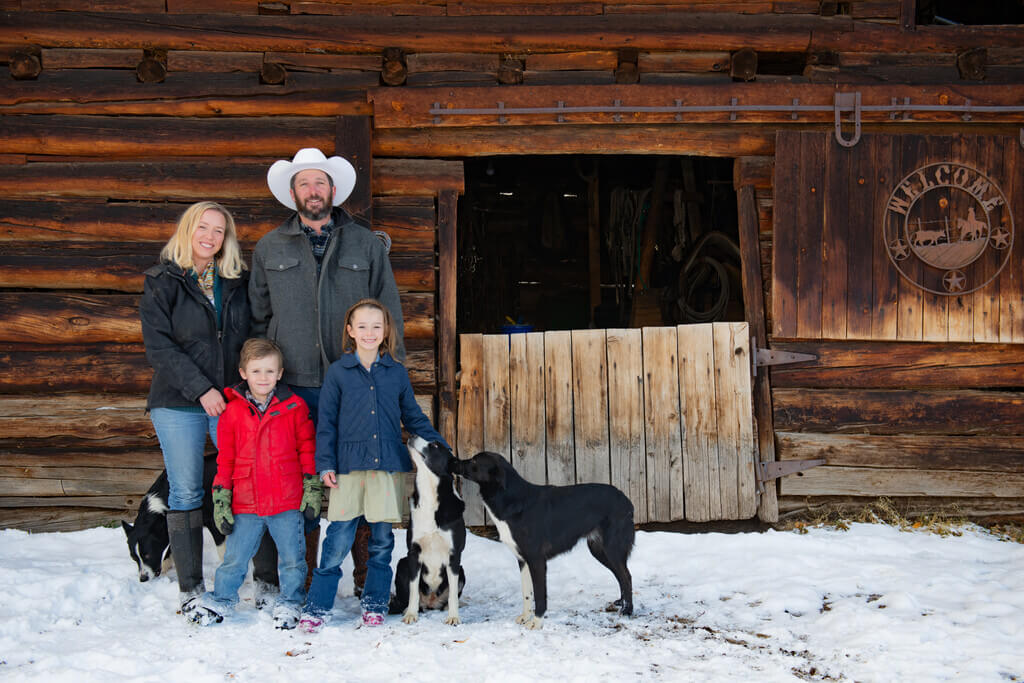
What time do you wake up on the ranch? Go to bed?
I’ve had little kids so have been exempt from the early mornings for the most part. Sheep are very scheduled creatures. They get up before the sun, graze out, sleep midday, graze at dusk, bed at dark. We set up sheep camp and sleep out there in the summers, as you need to be up before them. As the kids get older, they are starting to stay at sheep camp more. 4 a.m. comes early.
What is something most people are surprised to learn about life on a ranch?
I think probably the fact that you cannot leave. You can’t take vacations. There is no such thing as weekends or holidays off. Someone always has to be there. I leave and take the kids places, but their dad has to stay home and hold down the fort. Once in a while, during a slow month, he can get away since we still have his parents to watch the place.
What is a skill that you are working on?
I’ve always enjoyed learning and have a thirst for knowledge. So much so that I am actually going back to school this fall. I’ve enrolled at the University of Hawaii William S. Richardson School of Law and will pursue a Juris Doctorate through their online program.
Despite my science background and experience on the land, the majority of my professional work focuses on property law, where I craft, interpret, enforce and defend conservation easements. I often joke that I was trained as a scientist, but naturally think like a lawyer. At this point in my career, I now have two decades of experience negotiating and enforcing contracts from a landowner-centric perspective.
A law degree will allow me to expand my future options in this field, whether that is through continuing work at CCALT, consulting, teaching or in private practice representing landowners and land trusts. Most importantly, I believe a law degree, paired with my practical experience, will better enable me to serve the conservation field and deepen and broaden my impact. A voice like mine is needed as we face a future with deepening tensions between people and the natural world.
Favorite time of year on the ranch?
The fall has always been my favorite season. It’s so incredibly beautiful and so symbolic of the past season’s growth, preparing to incubating change over the impending winter.
Least favorite time of year?
Mud Season! We actually have two, though spring is the worst because you want nice weather to come and stay so badly, but it just teases you with hints of a warmer, greener future. Luckily, it’s also the season of birth and renewal, so the chaos of taking care of all those baby animals not only brings hope, but also makes it go faster.
What 3-5 emojis capture day-to-day life on the ranch?
Oh my gosh, clearly the poop emoji. To be a rancher is to be comfortable with a lot of poop. The tired emoji and forehead slap emoji also remind me of rolling with the punches.
What is one item that you must have on you at all times as a rancher?
A knife, a dog, dry socks and good shoes.
What is the best part of running this fourth- and fifth-generation ranch?
Raising my children to have this deep sense of place has been an amazing experience. They have two sets of great-grandparents buried on the ranch. Their connection is elemental. Generations of living off the land infused their bodies with the soil and water around them. They intrinsically know this place and its natural rhythms. They have memories of the past that my husband and I can’t explain. This is what I mean when I say the land becomes a member of the family. It’s so connected to you and your story and is a living, evolving force.
We could sell it all and our children would never have to work another day in their lives. But to then live with the loss of your story paints only a depressing outlook. Economic margins are slim in ranching and the work never-ending, but the fulfillment is immeasurable. I hope my children value their upbringing and become good people who fight for our natural world. Our ranch is in conservation easement. We’ve given up the rights to subdivide and develop it. We've bound future generations to that same promise. It’s the least we can do.
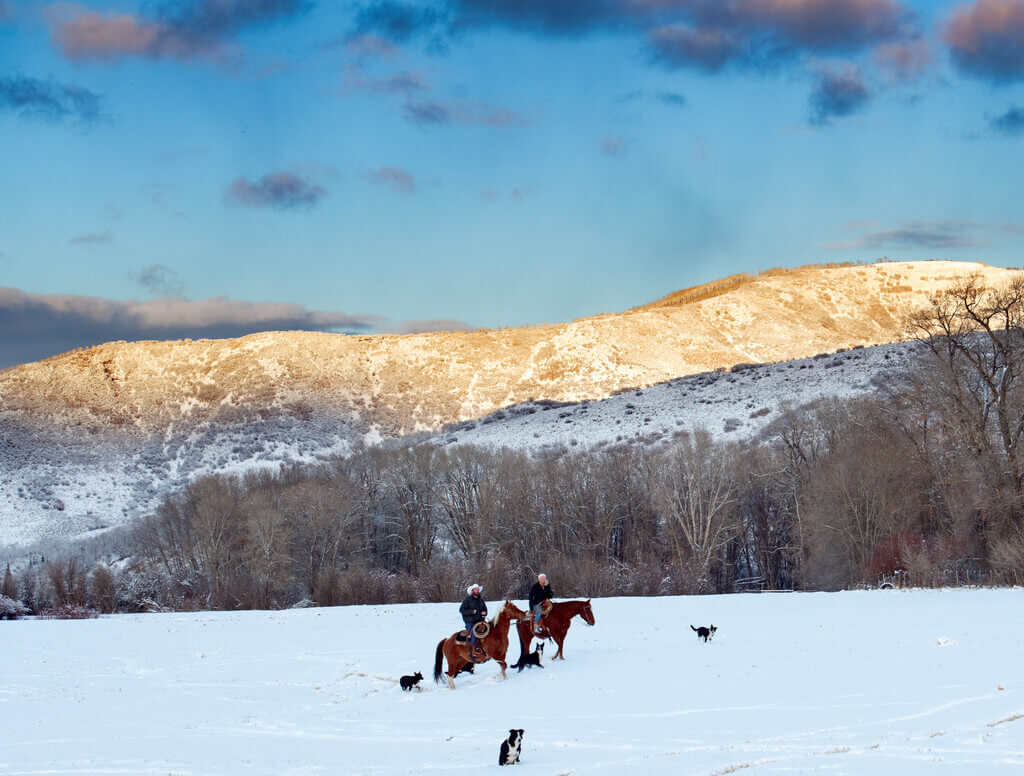
What is one of the biggest misconceptions folks have about ranching?
Our western environment is so fragile. It’s dry, the soils are poor, our growing season is a few short months before we are again buried in snow. I’ve seen it snow 18 inches at the end of June! We can’t farm here. It would destroy the natural environment. We can raise livestock. The livestock are also a land management tool, aiding in wildfire mitigation and altering species composition. I’ve put a lot of thought and research into sustainable food production. My conclusion always comes back to the best thing we as a society can do is eat locally produced products as much as we can. In this region, the most environmentally friendly food we can produce is meat. And, when local producers are held accountable to their communities, we also get ethically raised food.
What is your role with the Colorado Cattlemen’s Agricultural Land Trust?
My title is senior director of stewardship. I am charged with upholding the conservation easements that Colorado Cattlemen’s Agricultural Land Trust (CCALT) has accepted. A conservation easement is a voluntary agreement that a landowner may enter into with a qualified conservation organization. The main purpose is to restrict certain forms of development and uses of the landowner’s property in order to protect certain resources, defined in the conservation easement as “conservation values.”
Conservation easements are perpetual, meaning they last forever. We hold over 550 conservation easements across the state of Colorado on over 800,000 acres. We are the third-largest local land trust in the country. My job has multiple facets, but I primarily view it as risk mitigation. Strengthening contracts, creating policies and interpretation guidelines, and building cooperative relationships with farmers and ranchers across the state all help CCALT uphold our perpetual obligations to ensure the land continues to support our agricultural communities and natural environment.
What drew you to pursue master’s degrees in forestry and environmental management from the Nicholas School at Duke University?
I knew I didn’t want to spend my life in academia. I knew I wanted to be out affecting management of natural resources on the ground. Duke’s program was skills-intensive and hands-on. It was a fun program. We travelled all over the South to various forestry operations, participated in controlled burns, and I met a lot of really committed people I still work with today.
What does it mean to be a good steward of the land?
It means responsibly managing and caring for the natural resources and ecosystems, ensuring their health and well-being for present and future generations. The term itself implies guardianship. The act underscores your personal impermanence in the equation. We used to talk about sustainability. But sustainability means more of the same. We now talk about resiliency. How can we manage to adapt to change, which is inevitable? How do we keep going? To be a good steward means those thoughts keep you up at night.
ON HOLY CROSS
What made you choose Holy Cross?
Before I went, I had a dream that I was happy there. Maybe you think it’s strange to listen to dreams, but I think we all can see paths laid out before us, like energy trajectories that we can read if we are paying attention. I was never worried it was the wrong choice. More practically, I wanted to play softball and use my athletic skills to help me get into the best academic school I could. Holy Cross checked all those boxes for me. I loved my time there.
How do you think you are different because of your education from Holy Cross?
What I appreciated most about a liberal arts education isn’t so much what I learned but that it taught you how to learn and how to pursue and follow through on paths of learning that sparked you.
What was your favorite spot on campus?
I loved being outside amongst the ivy and the brick in the late afternoon light.
What was the most influential course you took at Holy Cross, and who taught it?
I loved all my ecology classes. I remember the first time I was introduced to the natural sciences, I could not believe it was considered school. I memorized the scientific name of every big cat species in the world when I was 8 — for fun! When I figured out studying nature could be a career path, I was all in.
Robert Bertin [Distinguished Professor of Science Emeritus, biology] was my ecology teacher. We worked together on a scientific study about the intrusion of Norway maple into New England forests. Later, I worked at Harvard Forest, studying the spread of hemlock wooly adelgid across New England’s forests. These early research projects definitely shaped my understanding of human impacts on the natural world: not only how we negatively impact ecosystems but also how we can positively shape their future through science and management.
I also took every Buddhism course available to me. I reflect back on my study of Buddhism quite often. Impermanence is constantly thrown in your face in ranch life. My kids have seen so much loss. I vividly remember sitting up one night a few years ago with my daughter as she begged me to ask God to save a dying lamb. It broke my heart to tell her God doesn’t work that way. The lamb was gone by morning, but the lessons stay with you. I hope they are gaining an appreciation for the fleeting beauty of life and valuing the present moment as everything is constantly changing. The further we move from the natural world as a society, the more insulated we are from cycles of life and death. I hope this childhood makes them more resilient adults.
What was the most influential experience you had at Holy Cross?
Playing softball and having a really close-knit team was probably my most impactful experience. Sports teach you so much about commitment, discipline, time management, teamwork and friendships.
Favorite Worcester spots?
My best friend, Kait, and I would frequently escape campus. We could be found running trails around the area’s reservoirs or hiking to the top of Mt. Wachusett. We also were patrons of Irish Times.
AND FINALLY …
What is the simplest part of your life?
Seriously nothing is simple, but I do manage to find moments of peace. The great horned owls are currently mating. I got my daughter out of bed the other night, and we walked a few steps into the forest in pitch black, except for the glorious stars, and listened to the cacophony of owl calls.
What do you think are the biggest challenges facing conservation and agriculture today?
In Colorado, recreational pressure is a huge challenge for conservation. Like all human uses, it needs to be balanced. Our population is growing and the pandemic has driven growth and development in rural recreational hot spots. Climate change, water scarcity and food security for a growing population are all mounting pressures we face. And on top of that, unfavorable public policy has been making it more difficult and expensive to provide food.
How can folks help support conservation efforts?
Vote with agriculture in mind. Vote for conservation measures. Eat locally produced food. Support your local nonprofit organizations who engage in conservation.
Anything else?
If anyone reading this is ever up in Steamboat Springs, get in touch! We are happy to give you a ranch tour as well and always love engaging people in agriculture.
